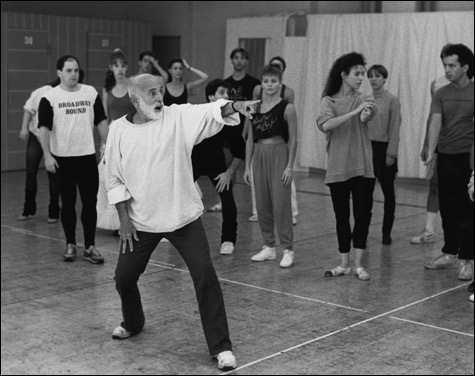
JEROME ROBBINS: A creative dynamo and terrorizing taskmaster — and the audience adored him no matter what he did. |
Hubbard Street Dance Chicago's Celebrity Series program at the Cutler Majestic last weekend could have been a primer of the ways not to dance ballet. All four dances sampled our taken-for-granted repertoire of everyday actions, gestures, and situations as a basis for movement. Working this way, the choreographer can develop the expertise and physicality of virtuoso ballet without the alienating effects of "technique." Hubbard Street dancers are terrific turners and jumpers and precision movers, and they also look friendly.
In the hands of Doug Varone, who comes out of the José Limón/Lar Lubovitch tradition of lyrical modern dance, this strategy can result in mesmerizing choreography. The Constant Shift of Pulse (2006) takes its title and its choreographic motor from John Adams's postminimalist two-piano Hallelujah Junction. The 12 dancers stream in and out, circling, meeting, falling, dispersing, pausing, clustering, lifting, as the music spins through seemingly repetitious but subtly shifting accents and cycles.
The stage fills and empties with small and large groups, whirlwinds and flat calm, the density or sparseness of motion created not by any individuals but by the way the whole ensemble is tuned to itself. Even when two men confront each other and fling themselves into strenuous combat, their duet isn't about who wins or loses. As in the martial-arts form capoeira, they reconnoiter, thrust and evade, hurl punches, and step away but don't ever make contact. Another couple take up the idea, and skirmishes break out all over. The pianos are hammering out chords, and the games seem to get more violent. But then you realize the music's racket is resolving into phrases that echo the syllables of "hallelujah." The dance resolves too, back into the soft meetings and pile-ups with which it began.
The other items on the program offered outright entertainment, from cuteness to hysteria. In Lickety-Split, by company dancer Alejandro Cerrudo, the three couples get moving with pushy gestures of unlikely body parts — an elbow, the side of the neck, the bottom of the ribcage. Although these couples are capable of embracing, running, balancing, and lifting each other, the quirkiness of the movement spares them from looking romantic, or maybe even real.
HSDC artistic associate Lucas Crandall's Gimme is still more eccentric. Jessica Tong and Jason Hortin are forever conjoined by a short piece of rope they're holding the ends of. You can dream up plenty of athletic metaphors for a relationship where one partner can get only three feet away before being reeled in or yanked around by the other.
Johan Inger comes out of the Royal Swedish Ballet and Nederlands Dans Theater, and his 2001 Walking Mad is an expert example of Euro-Dada, with menacing moving scenery and lights, joky movement, important but dispensable clothing, spastic love, and the kitschiest music in the world, Ravel's Boléro. The piece has the manic energy of Ohad Naharin's Minus series and the misogyny of Tanztheater. All the women seem to be victims; all the men are anti-heroes.
Five men dance a jittery, pelvis-grinding chorus line wearing tiny red dunce caps. Couples lock together and clump around like twin gorillas.